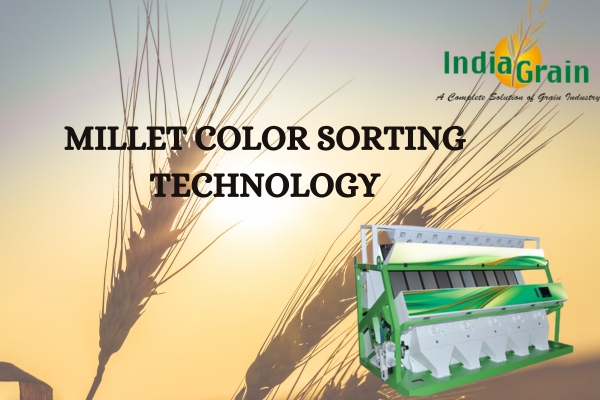
Blog-details
Posted By : Anil Yadav
Blog Date : 10th October, 2023
Millet Color Sorting Technology: Enhancing Quality and Efficiency in the Indian Food Industry
In the vibrant tapestry of Indian cuisine, millets hold a special place. These small grains have been a staple food for centuries, offering a rich source of nutrition and adaptability to various regional dishes. As the demand for high-quality millets continues to rise, the Indian food industry is embracing advanced technology to ensure that these grains meet the highest standards of purity and quality. One such technological innovation that is making a significant impact is the Millet color sorter machine in Delhi, particularly in Delhi. In this blog, we explore how Millet Color Sorting Technology is transforming the Indian food industry by enhancing the quality and efficiency of millet production.
The Significance of Millets in Indian Food Culture
Millet, often referred to as "Bajra" in Hindi, "Pearl Millet," "Finger Millet," and "Sorghum," are among the
ancient grains that have nourished generations in India. They are a staple in many Indian states, forming the
base of traditional dishes like roti, bhakri, and porridge. Millets are celebrated for their numerous health
benefits, including being gluten-free, rich in fiber, and packed with essential nutrients.
As the global demand for nutritious and gluten-free grains surges, India's millet production is on the rise.
However, to meet the stringent quality standards of both domestic and international markets, the Indian food
industry is turning to Millet color sorter machine in delhi.
How Millet Color Sorting Technology Works
Millet Color Sorter Machines employ cutting-edge technology to inspect and sort millet grains based on color
and
other quality parameters. The process involves the following steps:
Feeding : Millet grains are fed into the machine's hopper.
Scanning : As the grains pass through the machine, high-resolution
cameras capture images of each grain.
Color Analysis : Advanced software analyzes the color of each grain and
identifies any discolored or defective ones.
Sorting : A precise sorting mechanism separates the defective grains
from
the good ones using high-speed ejectors.
Collection : The sorted millet grains are collected in different
containers, with the defective grains diverted for further inspection or disposal.
Benefits of Millet Color Sorting Technology
Enhanced Quality Control : Millet Color Sorter Machines ensure that
only
high-quality, uniform, and blemish-free grains make it to the market. This guarantees superior taste and
nutritional value.
Increased Efficiency : Traditional methods of manual sorting are
time-consuming and labor-intensive. Millet Color Sorter Machines can process a large quantity of millets in a
fraction of the time, reducing processing costs.
Waste Reduction : By removing defective grains early in the process,
these machines significantly reduce wastage, leading to cost savings and increased profitability.
Export Quality Assurance : For Indian millet producers looking to
expand
their reach in international markets, Millet Color Sorting Technology ensures compliance with global quality
standards, thereby boosting export potential.
Customization : These machines can be tailored to sort millets based on
various criteria, including color, size, and shape, making them adaptable to the diverse range of millet
varieties produced in India.
Supporting Farmers : The adoption of Millet
color sorter machine in delhi
empowers millet farmers by ensuring fair pricing and consistent quality, ultimately contributing to rural
development.
Conclusion:
Millet Color Sorting Technology is revolutionizing the Indian food industry, particularly in Delhi, by
enhancing
the quality and efficiency of millet production. As millets gain recognition for their nutritional value and
gluten-free nature, the demand for high-quality grains is on the rise. Millet color
sorter machine in delhi are
playing a crucial role in meeting this demand while maintaining the authenticity and purity of this ancient
grain.
In a country where food is not just sustenance but a way of life, ensuring the highest quality standards in
millet production is a testament to India's commitment to providing nutritious and wholesome food to its
people
and the world. With Millet Color Sorting Technology, the future of millets in India's food industry looks
promising, as it continues to nourish and delight the taste buds of millions.
Frequently Asked Questions
Millet Color Sorting Technology is a process that uses advanced machinery to inspect and sort millet grains based on their color and quality parameters. High-resolution cameras capture images of each grain, and sophisticated software analyzes the color, identifying any discolored or defective grains. High-speed ejectors then separate the defective grains from the good ones.
Millet Color Sorting is crucial for the Indian food industry as it ensures that only high-quality millet grains make it to the market. This not only improves the overall quality of millet-based products but also enhances their nutritional value and taste.
The benefits include enhanced quality control, increased efficiency in processing, reduced wastage, compliance with export quality standards, customization options, and support for millet farmers by ensuring fair pricing and consistent quality.
Yes, Millet Color Sorting Machines can be tailored to sort millets based on various criteria, including color, size, and shape. This customization ensures that the technology is adaptable to the diverse range of millet varieties produced in India.
